
Disaster Psychology
One of the most psychologically traumatic events a person can experience is a disaster. Whether large or small, natural, man-made, or technological, all disasters have the potential to affect psychological health. In fact, the psychological impact of disasters is often far reaching and widespread, often affecting up to 10 times the number of people that are physically injured, according to Dr. Nancy Haugen, a psychologist specializing in disaster mental health.
Dr. Haugen goes on to relate that while getting someone with traumatic injuries to definitive care within the golden hour is key to survival, addressing the mental health trauma of disaster victims needs to occur within 30 days of the disaster (the “golden month”) to be most effective.
While disasters often present an immediate challenge to meeting basic needs, such as food, water, shelter, and medical care, the psychological trauma from a disaster must be concurrently addressed. Understanding the way psychological trauma manifests itself following a disaster can help us to recognize when it is happening and provide opportunities to intervene.
Key Steps in Recognizing the Psychological Impact of Disasters
1. Acknowledge that stress, anxiety, and other negative emotional reactions are a normal part of a person’s reaction to a disaster. It is often said that the psychological reactions to disasters are “normal people having a normal response to an abnormal situation.” Mild to moderate stress reactions during the emergency and early post-impact phases of a disaster are highly prevalent. Although some stress reactions may seem “extreme,” and cause distress, they generally do not become chronic problems. Most people recover fully from even moderate stress reactions within 6 to 16 months. But some people may suffer post-traumatic stress disorder after a disaster. And interventions to provide psychological care during the critical 30 days following a disaster can significantly assist the recovery process. Thus, it is important to recognize psychological trauma and seek help in the short-term and the long-term when appropriate.
2. Look for common symptoms of psychological trauma. Because of the potential long-term impact of disasters on survivors’ mental health, it is imperative that we stay aware of the signs and symptoms exhibited by someone who is experiencing mental trauma. Common signs and symptoms include:
|
Psychological |
Physiological |
|
|
If you observe one or more of these symptoms in those around you (or even yourself), they may be suffering from psychological trauma.
3. Seek care and treatment for psychological trauma. Although all of the symptoms listed above can be normal and common during a disaster, they indicate the presence of psychological trauma that deserves attention and treatment. Awareness of psychological trauma and the need for self-care is important for everyone involved in a disaster. The common strategies for managing stress on a daily basis also apply after a disaster, and serve as a foundation for further psychological care:
- Get sufficient sleep
- Eat a nutritious and balanced diet
- Exercise regularly
- Live a balanced life, including work, play, and rest
- Connect meaningfully with others in your circle
- Engage with spiritual resources that provide meaning
Recognizing the need for additional psychological care in the immediate aftermath of a disaster and being receptive to this care is key to healing process. Seeking care early for psychological trauma is imperative and often can be obtained from informal sources, such as family, friends, and first responders. Persistent psychological symptoms indicate a need for professional resources.
Psychological First Aid
Professional resources such as crisis counselors, therapists, psychologists, and clergy can provide a great resource to those with psychological trauma after a disaster. However, these professionals are not always readily accessible after a disaster due overwhelming need. Psychological first aid (PFA) is an approach that was created to empower anyone to provide immediate psychological care to those affected by a disaster.
Disasters have numerous impacts on people and communities, from loss of homes or community icons to physical injury or death of a loved one. Some risk factors associated with psychological trauma, according to the PsySTART Triage System, can include:
- The death of a family member or friend
- Directly witnessing serious injuries or death of another person
- Suffering injuries or getting sick because of the disaster
- Feeling one’s life or loved one’s lives were threatened
- Being trapped or unable to evacuate
- Missing family or friends
- Loss of home or important belongings
- Being forced to relocate or having family members relocate
- Changing schools or neighborhoods
- Losing a job due to the disaster
- Losing or having a pet die
- Financial problems resulting from the disaster
- Extended recovery efforts
Much like CPR and first aid has trained millions to intervene in a medical emergency, psychological first aid is an evidence-informed modular approach to assist children, adolescents, adult, and families in the immediate aftermath of disaster and terrorism. Psychological First Aid’s principal actions are to:
- Establish safety & security
- Connect to restorative resources
- Reduce stress related reactions
- Foster adaptive short-and long-term coping
- Enhance natural resilience (rather than preventing long term pathology)
Psychological first aid should be provided for individuals experiencing acute stress reactions and who appear to be at risk for significant impairment in functioning. It can also be used for those that appear to be less at risk, to build resilience and capacity for coping. In other words, it is meant to be widely available to disaster victims in the immediate aftermath of a disaster. Keep in mind what psychological first aid is not:
- It is not something only professionals can do
- It is not professional counseling
- It is not “psychological debriefing” in that PFA does not necessarily involve a detailed discussion of the event that caused the distress
- It is not asking someone to analyze what happened to them or to put time and events in order
- Although PFA involves someone being available to listen to people stories, it is not about pressuring people to tell them their feelings and reactions to an event
Psychological first aid promotes and provides an environment that is helpful to people’s long term recovery by helping them to feel safe and connected to other, providing them with access to social, physical and emotional support, and empowering them to help themselves, as individuals and communities.
Listen, Protect, and Connect
Learning to provide psychological first aid is not difficult, but does require some reflection and practice. A simple model for providing psychological first aid was developed by Dr. Merritt Schreiber and is outlined in the Listen, Protect and Connect: Family to Family, Neighbor to Neighbor handbook published by FEMA. Examples for each step in the “Listen, Protect, and Connect” approach are described as follows:
Listen
The first step in psychological first aid is to listen. This starts with a genuine interest and openness to listen to someone and their concerns. Active listening requires attention to the words that are being spoken, as well as how it is said (non-verbal communication, including tone, facial expressions and body language). Sometimes what is not said, or just the actions and behaviors observed after a disaster, are the only clues that will indicate how someone is coping. Listening can be facilitated through:
- Making the first move – Disaster victims may not approach you with their concerns. Reaching out to others with a simple, “how are you doing?” is often all that is needed to show your willingness to listen and start a conversation.
- Silence is okay – Being there for someone so they are not alone is important, even if they don’t want to talk about what happened.
- There are no right or wrong feelings – Everyone will have his or her own reactions and feelings. Avoid imposing your own feelings or worldview on someone else’s experience.
- Share what you know about common reactions – Letting others know what reactions are common after a disaster can help them understand that their reaction is shared by others and is normal.
- Listen to what works for them – Affirm what has helped them in the current recovery process or in prior experiences. Encourage them to build on these processes.
- Check back often – Circling back around to check on family, friends, and neighbors helps to reinforce that you really care and are there to listen.
Throughout the listening process, look for to the most pressing practical concern where you can provide assistance. Be aware of persistent or more severe reactions that might indicate a need for professional care.
Protect
The second step in delivering psychological first aid is to protect them from on-going stress. Protecting people from continued psychological trauma means addressing practical, basic needs, providing information and ideas, and connecting them with appropriate resources. Examples of this include:
- Provide first aid that addresses physical injuries.
- Address the “basics” such as food and water, or a warm blanket. This can also mean providing for basic needs such as assistance with transportation or childcare, or connecting them with resources such as FEMA or Red Cross recovery centers.
- Express sympathy and support through your continued presence, even if you cannot “fix” the underlying problem.
- Answer questions about what happened with honest and factual information. It is also okay to acknowledge if you do not know, as information in a disaster changes rapidly.
- Get updated and current information about current response and recovery resources so you can be a conduit of information and provide referrals.
- Encourage positive coping by building on what works for them (and avoids destructive coping such as drugs or alcohol).
- Affirm their ideas and strategies by believing in them and their efforts.
The following strategies are important for disaster survivors as well as for ourselves, as we care for others in the disaster environment.
- Reduce further disaster exposure by avoiding unnecessary exposure to the sights, sounds, and smells associated with the disaster scene.
- Encourage survivors to limit their exposure to media coverage that repeats images of the disaster or continually discusses the impact (this includes social media). Exposure to media will not change or benefit the situation, but can make psychological trauma worse.
- Encourage healthy behaviors and non-disaster related activities, including rest, relaxation, regular meals, and exercise.
- Develop a safety plan in order to lessen worries about another disaster.
- Keep an eye on children by never leaving them alone. Children need to know that they are protected by trusted adults, whether it is by parents or family members.
Connect
The final step in providing psychological first aid is to connect. Creating a sense of community and connectedness after a disaster is one of the most beneficial actions to protect psychological wellbeing. This can start with assisting with first aid, helping to locate family members, sharing basic resources you are able to share, and providing others with helpful resources found in your area. It also means:
- Spending extra time with family and friends to listen and protect
- Continue connecting – by building new friendships and maintaining old relationships
Seek Long-term Treatment, if Necessary
While psychological first aid will help to address the immediate psychological reaction to a disaster, it may not be enough. If physical or psychological signs and symptoms persist beyond the first few days or weeks after the disaster, it is important to seek ongoing mental healthcare with professionals trained to address these issues.







